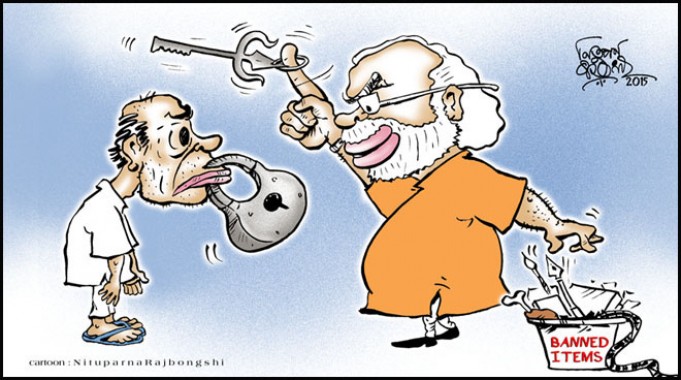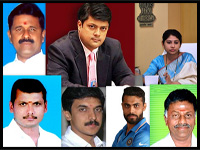Taking offence – the new reflex action
Three weeks into September and we’ve notched up such an impressive tally of threats, bans, blocks, notices, court observations and detentions that if we keep at it we will give China a complex. All in this month.
Between the Ministry of Information & Broadcasting (I&B) and Hindus, Muslims and the courts, everybody is just waiting to take offence. For a country with serious problems to worry about, the list of non-issues agitating both citizens and the powers that be is breathtaking.
The Supreme Court is concerned that a section of society may perceive homosexuality as akin to “social evils”. So it passes an interim order denying an entertainment tax exemption to a film based on the true story of the gay prince of Rajpipla in Gujarat. Evidently, some bits of history we do not like. The Gujarat government had appealed against a High Court order allowing tax exemption to the film.
A worthy at the Raza academy in Mumbai is demanding that the Home Ministry take legal action against music composer A. R. Rahman for scoring the music for an Iranian film which had a depiction of the Prophet, which in itself is a blasphemous act. Has the film been shown here? No, he saw it on a website.
The police and courts at Bilaspur in Chhattisgarh are spending time that could have been spent on more pressing issues in an insurgency-affected state on the offence caused by the creation of a WhatsApp group which had shared an “inappropriate and insulting” video of the Mahatma. Arrests are made and two people are produced before a court which grants bail.
While this state machinery in a BJP-ruled state is springing to action to ensure that the Mahatma’s image is not sullied, a newspaper breaks a story about the central government springing into action earlier this year to make sure that Gandhi’s assassin’s name is not sullied! By the Gujarati TV channel GSTV. That, of course, is the smaller reason for getting a notice from the I&B Ministry - the real reason is probably the channel’s uncomplimentary reference in a programme to an un-Gandhi like leader who wears a Rs 9 lakh suit.
Monitoring free speech news in this country is becoming a stressful business. The sentinels of what is right, respectful and permissible are growing in number, popping up from behind every bush:
Cricketer M. S. Dhoni attracts a Karnataka High Court notice for posing as Vishnu on a magazine cover.
Rajnikanth gets a hard rap from a BJP group for considering an offer to play Tipu Sultan in a film.
The Censor Board okays and then blocks a film on the assassins of General A. S. Vaidya.
In Kerala, a Hindu group stops a Muslim from writing a column on the Ramayana.
The film MSG 2 - The Messenger is banned in Chhattisgarh and Jharkhand because it ostensibly makes derogatory remarks about tribal people. And it is causing protests in Punjab because people there are agitated about its being banned elsewhere!
Finally, inept government departments are being pressed into service for the image management of those who rule. Most democracies would be embarrassed to own up to an Electronic Media Monitoring Centre (EMMC) where government-employed gnomes sit around monitoring TV channels in the country round the clock.
In Delhi, however, this organisation occupies a fair amount of land on the edge of the city and says it monitors up to 300 TV channels, a figure that will rise to 1500, this government declared in March this year.
On its website, the links don’t work, and it has trouble putting out its annual report. The latest one is for 2013 and when you click on it you find an extract from the annual report, not the whole thing. But the EMMC has become hyperactive of late, identifying telecasts for which channels can be nailed by the I&B Ministry. Three such notices were issued in August as a result of the EMMC’s labours and two were issued earlier this year.
Under this government, the brief is to safeguard the PM’s image. A few days ago, the Hindu reported that it will also monitor footage showing the I&B Minister and the Minister for I&B State. Whatever for? This is unprecedented and why hasn’t the Opposition leapt on this nugget?
The good news is that successful media companies are no pushovers; they are inclined to go to court to tell the government where to get off. That includes both big ones and small ones. Sun TV is battling it out in court in a different context, and the Tamil language Sathiyam TV - which received show cause notices for two programmes - has been steadily fighting it out, filing a case in the Delhi High Court it was reported this month.
If things get rough for GSTV over the Gandhi-Modi comparison, it is most likely to seek legal recourse as well. Because in the absence of a regulator, the I&B Ministry’s idea of punishment is purely arbitrary. It can order a channel to shut down for a specified period of time.
Sathiyam TV is a news and gospel TV channel which received a warning for a programme called 'Ungal Aseervatha Neram', apparently made reference to a 'dreadful man' as a threat to Christianity “by one preacher of the Christian faith”. (The I&B Ministry’s language.) The Ministry thought statements like this “could potentially give rise to a communally sensitive situation”.
A second programme on the same channel, titled ‘Parthathum Padithathum’ attracted the Ministry’s attention because a senior journalist was “making some statements against the Prime Minister”.
Again, in the Ministry’s language, “one senior journalist participating in the News Analysis alleged that the Prime Minister engineered crowds at his rallies and also influenced the media to project an incorrect picture as true.” Both these offences apparently violate Rule 6(1Xd) & (i) of the Programme Code.
Subsequently Sathiyam TV has received notices for other violations. In its petition to the Delhi High Court it has contended, “Open criticism of government policies and operations are not a ground for restricting expression”.
The private sector will fight back, moving the courts when necessary. But when individuals are up against fringe groups, who tells the latter where to get off?









